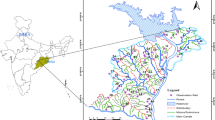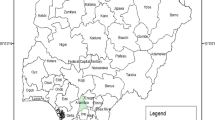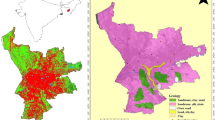Abstract
Developing a predictive decision model for assessing the vulnerability of hidden groundwater reservoir formation to contamination risk via unavoidable anthropogenic activities is a key to managing water resources looming security crisis globally. This study explored multiple and robust methodologies including GIS, analytical hierarchy process (AHP)-based data mining, statistical and geophysical techniques for developing a novel “GODL” vulnerability method: a modified GOD model to ameliorate these challenges. The input for the modeling was based on the 65 located depth sounding geophysical data occupied in a schist belt environ, Southwestern Nigeria. From the geophysical data interpreted results, four factors, namely, groundwater hydraulic confinement (G), aquifer overlying strata (O), depth to water table (D), and longitudinal conductance (L), regarded as aquifer vulnerability causative factors (AVCFs) were derived. The GIS-based produced AVCFs’ themes were synthesized by employing the conventional GOD and the AHP-driven GODL algorithms. Based on these algorithms applied results, the GOD-based aquifer vulnerability prediction zone map and GODL-based aquifer vulnerability prediction zone (AVPZ) map were produced in GIS environment. The produced AVPZ maps were validated by applying the statistical model evaluation to the water chemistry correlation results. The validation result exhibits 70% prediction accuracy for the developed GODL model compared with 66% for the GOD model. The GODL model demonstrated better performance than the GOD model. The AVPZ maps produced in this study can be used for precise decision-making process in environmental planning and groundwater management.








Similar content being viewed by others
References
Abiola, O., Enikanselu, P. A., & Oladapo, M. I. (2009). Groundwater potential and aquifer protective capacity of overburden units in Ado-Ekiti, southwestern Nigeria. International Journal of Physical Sciences, 4(3), 120–132.
Adelana, S. M. A., Olasehinde, P. I., & Bale, R. B. (2008). An overview of the geology and hydrogeology of Nigeria. Adelana ch011.tex 17/4/2008 11(55), 171–198. https://doi.org/10.1201/9780203889497.ch11
Ademeso, O. A., Adekoya, J. A., & Adetunji, A. (2013). Further evidences of cataclasis in the Ife Ilesa schist belt. Southwestern Nigerian Journal Natural Science Research, 11, 50–59.
Afolayan, J. F., Olorunfemi, M. O., & Afolabi, O. (2004). Geoelectric/Electromagnetic VLF Survey for Groundwater Development in a Basement Terrain – A Case Study. Ife Journal of Science, 6(i), 74–78.
Afonso M. J., Pires A, Chamine H. I., Marques J. M., Guimaraes L., Guilhermino L. (2008). Aquifer Vulnerability assessment of urban areas using a GIS based cartography: Paranhos groundwater pilot site, Porto, NW Portugal. Global Groundwater Resource and Management, 259–278.
Akinlalu, A. A., Adegbuyiro, A., Adiat, K. A. N., Akeredolu, B. E., Lateef, W. Y. (2017). “Application of multi-criteria decision analysis in prediction of groundwater resources potential: a case of Oke-Ana, Ilesa Area, Southwestern, Nigeria” NRIAG Journal of Astronomy and Geophysics, Vol 6, pp. 182–200.
Al-Hanbali, A., & Kondoh, A. (2008). Groundwater vulnerability assessment and evaluation of human activity impact within the Dead Sea groundwater basin. Jordan. Hydrogeology Journal, 16(3), 499–510.
Ako, B. D., & Olorunfemi, M. O. (1989). Geoelectric survey for groundwater in the Newer Basalts of Vom Plateau State. Nig Journal of Mining and Geology, 25(1 & 2), 247–450.
Al-Saud, M. (2010). Mapping potential areas for groundwater storage in Wadi Aurnah Basin, Western Arabian Peninsula, using remote sensing and geographic information system techniques. Hydrogeology Journal, 18, 1481–1495.
Aller, L., Bennett, T., Lehr, J., Petty, R., & Hackett G. (1987). DRASTIC: A standardized system for evaluation ground water pollution potential using hydrogeological settings. National Water Well Association, Dublin, Ohio and Environmental Protection Agency, Ada, Ok.EPA-600/2–87–035.
Althuwaynee, O. F., Pradhan, B., & Lee, S. (2012). Application of an evidential belief function model in landslide susceptibility mapping. Computers & Geosciences, 44(2012), 120–135.
Aniya, F. B., & Shoeneick, K. (1992). Hydrogeological investigation of the aquifer of Bauchi Area. Journal of Mining and Geology, 28(1), 45–53.
Aweto, K. E. (2011). Aquifer vulnerability assessment at Oke-Ila area, Southwestern Nigeria. International Journal of Physical Science 6 (33), 7574–7583.
Ayantobo, O. O., Awomeso J. A., Oluwasanya G. O., Bada B. S., & Taiwo, A. M. (2014). Gold mining in igun-ijesha, Southwest Nigeria: impacts and implications for water quality.
Badmus, B. S., & Olatinsu, O. B. (2010). Aquifer characteristics and groundwater recharge pattern in a typical basement complex, Southwestern Nigeria. African Journal of Environmental Science and Technology, 4(6), 328–342. https://doi.org/10.5897/AJEST09.214
Barker, R., Rao, T. V., & Thangarajan, M. (2001). Delineation of contaminant zone through electrical imaging technique. Current Science, 81(3), 277–283.
Bayode, S., Ojo, J. S., & Olorunfemi, M. O. (2006). Geoelectric characterization of aquifer types in the basement complex terrain of parts of Osun State, Nigeria. Global Journal of Pure and Applied Sciences, 12(3), 377–385.
Bhattacharya, P. K., & Patra, H. P. (1968). Direct-current geoelectric sounding Principles and interpretation: New York, Elsevier Publishers, 139 p.
Braga, A. C. O., Dourado, J. C., & Malagutti, F. W. (2006). Resistivity (DC) method applied to aquifer protection studies. Brazilian Journal of Geophysics, 24(4), 573–581.
Braga, A. C. O., Francisco, R. F. (2014). Natural vulnerability assessment to contamination of unconfined aquifers by longitudinal conductance – (s) method, Journal of Geography and Geology, Vol. 6, No. 4; 2014; ISSN 1916–9779; E-ISSN 1916–9787, pp. 68–79.
Butscher, C., & Huggenberger, P. (2008). Intrinsic vulnerability assessment in karst areas: A numerical modeling approach. Water Resources Research 44(W03408).
Chandra, L., Seidel, S., Gregor, S. (2015). Prescriptive knowledge in IS research: conceptualizing design principles in terms of materiality, action, and boundary conditions. In: 48th Hawaii international conference on system sciences, Kauai. IEEE, pp 4039–4048.
Chen, Y., Xu, W., Shen, H., Yan, H., He, Z., & Ma, M. (2013). Engineering arsenic tolerance and hyperaccumulation in plants for phytoremediation by a PvACR3 transgenic approach. Environmental Science and Technology, 47, 9355–9362. https://doi.org/10.1021/es4012096
Doerfliger, N., Jeannin, P. Y., & Zwahlen, F. (1999). Water vulnerability assessment in karst environments: a new method of defining protection areas using a multi-attribute approach and GIS tools (EPIK method). Environmental Geology, 39(2), 165–176.
Evans, U. F., Abdusalam, N. N., & Mallam, A. (2017). Natural vulnerability estimate of groundwater resources in the coastal area of Ibaka Community, using Dar Zarrouk geoelectrical parameters. Journal of Geology & Geophysics., 6, 4. https://doi.org/10.4172/2381-8719.1000295
Flint, A. L., Flint, L. E., Kwicklis, E. M., Fabryka-Martin, J. T., & Bodvarsson, G. S. (2002). Estimating recharge at Yucca Mountain, Nevada, USA: comparison of methods. Hydrogeol J (in press). https://doi.org/10.1007/s10040-001-0169-1
Focazio, M. J., Reilly, T. E., Rupert, M. G., & Helsel, D. R. (2002). Assessing ground-water vulnerability to contamination: Providing scientifically defensible information for decision makers, U.S. Geological Survey Circular 1224, Denver, San Francisco, USA.
Foster, S. (1987). Fundamental concepts in aquifer vulnerability, pollution risk and protection strategy. In: Van Duijvenbooden W, Van Waegeningh HG (eds), Vulnerability of soil and groundwater to pollutants. Proc Inf TNO Comm Hydrol Res, The Hague 38:69–86.
Foster, S., Hirata, R., Gomes, D., Elia, M. D., Paris, M. (2002). Groundwater Quality Protection A guide for water utilities, municipal authorities and environment agencies. The World Bank. ISBN 0–8213–4951–1.
Frind, E. O., Molson, J. W., & Rudolph, D. L. (2006). Well vulnerability: A quantitative approach for source water protection. Ground Water, 44(5), 732–742.
FSN. (1966). Topographic Map Series:Ilesha Sheet 243 (SW & SE). Scale 1:50,000. Federal Survey of Nigeria (FSN).
Gad, M. I., El-Kammar, M. M., Ismail, H. M. G. (2015). Groundwater vulnerability assessment using different overlay and index methods for quaternary aquifer of Wadi El-Tumilat, East Delta, Egypt. Asian Review of Environmental and Earth Sciences. Vol 2 No 1. Pp.
Ghazavi, R., & Ebrahimi, Z. (2015). Assessing groundwater vulnerability to contamination in an arid environment using DRASTIC and GOD models. International Journal of Environmental Science and Technology, 2015(12), 2909–2918. https://doi.org/10.1007/s13762-015-0813-2
Gogu, R. C., & Dassargues, A. (2000). Current trends and future challenges in groundwater vulneribility assessment using overlay and index methods. Environmental Geology, 39, 549–559.
Gogu, R. C., Hallet, V., & Dassargues, A. (2003). Comparison of aquifer vulnerability assessment techniques: Application to the Neblon river basin (Belgium). Environmental Geology, 44(8), 881–892.
Helsel, D. R., & Hirsch, R. M. (1992). Statistical methods in water resources. In Techniques of waterresources investigations of the United States Geological Survey; Book 4, Hydrologic Analysis and Interpretation. US Geological Survey, Reston, VA. Chapter A3.
Henriet, J. P. (1975). Direct applications of the Dar Zarrouk parameters in ground water surveys. Geophysical Prospecting, 24, 344–353. https://doi.org/10.1111/j.1365-2478.1976.tb00931.x
Jamrah A., Al-Futaisi, A., Rajmohan, N. and Al-Yaroubi, S. (2008). Assessment of groundwater vulnerability in the coastal region of Oman using DRASTIC index method in GIS environment.
Keary, P., Brooks, M., & Hill, I. (2004). An Introduction to Geophysical Exploration (3rd Edition) (p. 262). Blackwell Science.
Knouz, N., Bachaoui, E., & Boudhar, A. (2017). Cartography of intrinsic aquifer vulnerability to pollution using GOD method: Case study Beni Amir groundwater (pp. 1046–1053). Tadla.
LaMotte, A. E., & Greene, E. A. (2007). Spatial analysis of land use and shallow groundwater vulnerability in the watershed adjacent to Assateague Island National Seashore, Maryland and Virginia, USA. Environmental Geology, 52(7), 1413–1421.
Lee, S., Kyo-Young S., Kim, Y., Park, I. (2012). Regional groundwater productivity potential mapping using geographic information system (GIS) based artificial neural network model. Hydrogeol J. 1–17.
Liggett, J., Allen, D., Journeay, M., Denny, S., Talwar, S., & Ivey, L. (2006). Intrinsic aquifer vulnerability maps in support of sustainable community planning, Okanagan Valley, BC. In 59th Canadian Geotechnical Conference and 7th Joint CGS/ IAH-CNC Groundwater Specialty Conference, Vancouver, BC
Liggett, J. E., & Talwar, S. (2009). Groundwater vulneribility assessments and integrated water resource management. Watershed Management Bulletin, 13(1), 18–29.
Loke, M. H. (2001). Electrical Imaging surveys for environmental and engineering studies. A practical guide to 2-D and 3-D surveys. RES2DINV Manual. IRIS Instruments. www.iris-intruments.com
Maria, R. (2018). Comparative studies of groundwater vulnerability assessment. Global Colloquium on GeoSciences and Engineering 2017. IOP Conf. Series: Earth and Environmental Science 118 (2018) 012018 https://doi.org/10.1088/1755-1315/118/1/012018
Mogaji, K. A., Omosuyi, G. O., Adelusi, A. O., & Lim, H. S. (2016). Application of GIS-based evidential belief function model to regional groundwater recharge potential zones mapping in hardrock geologic terrain. Environmental Processes, 3(1), 2016.
Mogaji, K. A. (2017). Development of AHPDST vulnerability indexing model for groundwater vulnerability assessment using hydrogeophysical derived parameters and GIS application. Pure and Applied Geophysics, 2017(174), 1787–1813. https://doi.org/10.1007/s00024-017-1499-9
Mogaji, K. A., & Omobude, S. B. (2017). Modeling of geoelectric parameters for assessing groundwater potentiality in a multifaceted geologic terrain, Ipinsa Southwest, Nigeria – A GISbased GODT approach. NRIAG Journal of Astronomy and Geophysics., 6(2), 434–451. https://doi.org/10.1016/j.nrjag.2017.07.001
Nampak, H., Pradhan, B., & Manap, M. A. (2014). Application of GIS based data driven evidential belief function model to predict groundwater potential zonation. Journal of Hydrology, 513, 283–300.
National Research Council (NRC). (1993). Ground water vulnerability assessment, contamination potential under conditions of uncertainty: National Academy Press (p. 210). D.C.
Neukum, C., & Hötzl, H. (2007). Standardization of vulnerability maps. Environmental Geology, 51, 689–694.
Nigerian Geological Survey Agency (NGSA). (2006). Airborne Geophysical Survey Residual Magnetic Intensity Map of Ilesa (sheet) Area.
Nigerian Mining Corporation (NMC). (1987). Mining industry of Nigeria retrieved from Nomanbhay, S.M. and K. Palanisamy, 2005. Removal of heavy metal from industrial wastewater using chitosan coated oil palm shell charcoal. Electronic Journal of Biotechnology.
Nigerian Standard for Drinking Water Quality (NSDWQ). (2007). Nigerian Standard for Drinking Water Quality. NIS 554: ICS, 13.060.20:14–16.
Nobre, R. C. M., Filho, O. C. R., Mansur, W. J., Nobre, M. M. M., & Cosenza, C. A. N. (2007). Groundwater vulnerability and risk mapping using GIS, modeling and a fuzzy logic tool. Journal of Contaminant Hydrology, 94(3–4), 277–292.
Nowlan, L. (2005). Buried treasure: Groundwater permitting and pricing in Canada. Walter and Duncan Gordon Foundation, with case studies by Geological Survey of Canada, West Coast Environmental Law, and Sierra Legal Defence Fund.
Oladapo, M. I., Mohammed, M. Z., Adeoye, O. O., & Adetola, B. A. (2004). Geo-electrical Investigation of Ondo State Housing Coperation Estate. Ijapo, Akure, South Western Nigeria, Journal of Mining Geology, 40(1), 41–48.
Olorunfemi, M. O., & Fasuyi, S. A. (1993). Aquifer types and the geo-electric/hydrogeologic characteristics of part of the central basement terrain of Nigeria (Niger State). Journal of African Earth Sciences, 16(3), 309–317.
Oluwasanya, G. O. (2006). Assessment of rainwater harvesting in rural household water supply-a case of Otofure village, Erua/Ishan region, Edo State, Nigeria. Journal o the Nigerian Meteorological Society, 6, 70–81.
Oni, T. E., Omosuyi, G. O., & Akinlalu, A. A. (2017). Groundwater vulnerability assessment using hydrogeologic and geoelectric layer susceptibility indexing at Igbara Oke, southwestern Nigeria. NRIAG Journal of Astronomy and Geophysics, 6(2), 452–458. https://doi.org/10.1016/j.nrjag.2017.04.009
Orellana, Ernesto, and Mooney, H. M., (1966). Master tables and curves for vertical electrical sounding over layered structures: Madrid, Interciencia, 150 p., 66 tables.
Popescu I.C, Gardin N., Brouyére S., Dassargues, A. (2008). Groundwater vulnerability assessment using physically-based modeling: from challenges to pragmatic solutions. In ModelCARE 2007 proceedings, calibration and reliability in groundwater modeling. Refsgaard JC, Kovar K, Haarder E, Nygaard E (eds), Denmark.IAHS Publication No. 320
Rahaman, M. A. (1988). Recent Advances in the Study of the basement complex of Nigeria. Oluyide PO (Coordinator) (pp. 11–43). Precambrian Geology of Nigeria. Geological Survey of Nigeria.
Rahmati, O., Naser, T., Farhad, N., & Saro, L. (2016). Spatial analysis of groundwater potential using weights-of-evidence and evidential belief function models and remote sensing. Arabian Journal of Geosciences, 9, 79. https://doi.org/10.1007/s12517-015-2166-z
Razandi, Y., Pourghasemi, H. R., Neisani, N. S., & Rahma, O. (2015). Application of analytical hierarchy process, frequency ratio, and certainty factor models for groundwater potential mapping using GIS. Earth Science Informatics, 8(4), 867–883.
Saaty, T. L. (1980). The Analytic Hierarchy Process; Planning, Priority Setting. Resource Allocation.
Sahoo, S., Dhar, A., Kar, A., Chakraboty, D. (2016). Index-Based Groundwater Vulnerability Mapping Using Quantitative Parameters. Environmental Earth Sciences 75(522). https://doi.org/10.1007/s12665-016-5395-x
Sharma, S. P., & Kaikkonen, P. (1999). Appraisal of equivalence and suppression problems in 1-D EM and DC measurements using global optimization and joint inversion. Geophysical Prospecting, 47, 219–249.
Todd, D. K. (1980). Groundwater Hydrology (2nd ed., p. 1978). van der Meer.
Tropical Mines Limited TML. (1996). A Pre-Investment Study of the Primary Goldmine-Odo Ijesa (primary) Gold Deposit Report, 2: 1–12. Ayantobo et al American Journal of Environmental Sciences 10 (3): 289–300, 2014.
United Nations SDG Website (2019): Goal 6, Ensure access to water and sanitation for all, Retrieved from https://www.un.org/sustainabledevelopment/water-and-sanitation/
Vander-Velpen, B. P. A. (2004). RESIST Version 1.0. M.Sc. Research Project. ITC, Delft Netherlands.
Van Stempoort, D., Ewert, L., & Wassenaar, L. (1993). Aquifer vulnerability index (AVI): a GIS compatible method for groundwater vulnerability mapping. Canadian Water Resources Journal, 18, 25–37.
Vias J. M, Andreo B., Perles M. J., Carrasco F. (2005). A comparative study of four schemes for groundwater vulnerability mapping in a diffuse flow carbonate aquifer under Mediterranean climatic conditions, Environmental Geology, 47 586–595.
Wei, M. (1998). Evaluating AVI and DRASTIC for assessing pollution potential in the Lower Fraser Valley, British Columbia: Aquifer vulnerability and nitrate occurrence. In CWRA 51st Annual Conference – Mountains to sea: Human interaction with the hydrologic cycle, Victoria, BC.
Wikipedia. (2017). Deviation (Statistics), retrieved from: http://en.wikipedia.org/wiki/Deviation (statistics), date accessed: 12th November, 2017.
Whitsell, W. J., & Hutchinson, G. D. (1973). Seven danger signals for individual water supply. Transactions of the ASAE., 16, 777–781.
Wright, E. P. (1992). The hydrogeology of crystalline basement aquifers in Africa. Geological Society Special Publication No, 66, 1–27.
Author information
Authors and Affiliations
Corresponding author
Additional information
Publisher's Note
Springer Nature remains neutral with regard to jurisdictional claims in published maps and institutional affiliations.
Rights and permissions
About this article
Cite this article
Akinlalu, A.A., Mogaji, K.A. & Adebodun, T.S. Assessment of aquifer vulnerability using a developed “GODL” method (modified GOD model) in a schist belt environ, Southwestern Nigeria. Environ Monit Assess 193, 199 (2021). https://doi.org/10.1007/s10661-021-08960-z
Received:
Accepted:
Published:
DOI: https://doi.org/10.1007/s10661-021-08960-z




